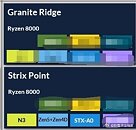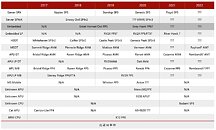
AMD Speeds Up Development of "Zen 5" to Thwart Intel Xeon "Emerald Rapids"?
In no mood to cede its market-share growth to Intel, AMD has reportedly decided to accelerate the development of its next-generation "Zen 5" microarchitecture for debut within 2023. In its mid-2022 presentations, AMD had publicly given "Zen 5" a 2024 release date. This is part of a reading-in-between the lines for a recent GIGABYTE press release announcing server platforms powered by relatively low-cost Ryzen desktop processors. The specific sentence from that release reads "The next generation of AMD Ryzen desktop processors that will come out later this year will also be supported on this AM5 platform, so customers who purchase these servers today have the opportunity to upgrade to the Ryzen 7000 series successor."
While the GIGABYTE press release speaks of a next-generation Ryzen desktop processor, it stands to reason that it is referencing an early release of "Zen 5," and since AMD shares the CPU complex dies (CCDs) between its Ryzen client and EPYC server processors, the company is looking at a two-pronged upgrade to its processor lineup, with its next-generation EPYC "Turin" processor competing with Xeon Scalable "Emerald Rapids," and Ryzen "Granite Ridge" desktop processors taking on Intel's Core "Raptor Lake Refresh" and "Meteor Lake-S" desktop processors. It is rumored that "Zen 5" is being designed for the TSMC 3 nm node, and could see an increase in CPU core count per CCD, up from the present 8. TSMC 3 nm node goes into commercial mass-production in the first half of 2023 as the TSMC N3 node, with a refined N3E node slated for the second half of the year.
While the GIGABYTE press release speaks of a next-generation Ryzen desktop processor, it stands to reason that it is referencing an early release of "Zen 5," and since AMD shares the CPU complex dies (CCDs) between its Ryzen client and EPYC server processors, the company is looking at a two-pronged upgrade to its processor lineup, with its next-generation EPYC "Turin" processor competing with Xeon Scalable "Emerald Rapids," and Ryzen "Granite Ridge" desktop processors taking on Intel's Core "Raptor Lake Refresh" and "Meteor Lake-S" desktop processors. It is rumored that "Zen 5" is being designed for the TSMC 3 nm node, and could see an increase in CPU core count per CCD, up from the present 8. TSMC 3 nm node goes into commercial mass-production in the first half of 2023 as the TSMC N3 node, with a refined N3E node slated for the second half of the year.












